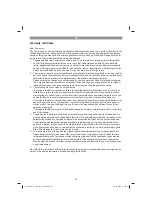
GB
- 17 -
battery with the lower charge level. The two batte-
ries must always be fully charged before use.
5.3 Charging the battery (Fig. 5)
1. Take the battery pack out of the equipment.
Do this by pressing the pushlock button.
2. Check that your mains voltage is the same as
that marked on the rating plate of the battery
charger. Insert the power plug of the charger
(D) into the socket outlet. The green LED will
then begin to blink.
3. Insert the battery pack (E) into the charger
(D).
4. In section 11. „Charger indicator“ you will
fi
nd
a table with an explanation of the LED indica-
tor on the charger.
The battery pack can become a little warm during
the charging. This is normal.
If the battery pack fails to charge, check:
•
whether there is voltage at the socket outlet
•
whether there is good contact at the charging
contacts
If the battery pack still fails to charge, send
•
the charging unit
•
and the battery pack
to our customer service center.
To ensure that the battery pack provides long ser-
vice, you should take care to recharge it promptly.
You must recharge the battery pack when you
notice that the power of the cordless leaf blower
drops. Never fully discharge the battery pack. This
will cause it to develop a defect.
5.4 Fitting the harness (Fig. 3c/3d)
Fasten the harness (Fig. 3c / Item 4) to the eyelet
(Fig. 3c / Item A) on the motor housing. Place the
harness over your shoulder and adjust the length
to that you can guide the equipment comfortably.
Caution: Carry the harness so that the click
fastener is always within reach. In an emer-
gency you can quickly remove the equipment
by opening the click fastener (Fig. 3d / Item
B).
6. Operation
6.1 Switching on the equipment (Fig. 6)
•
To switch on, press and hold the On/Off
switch (2).
•
To switch off, let go of the On/Off switch.
•
Channel the air stream forward and walk
slowly to blow foliage or garden refuse into a
pile or to clear out hard-to-reach places.
6.2. Speed control (Fig. 6)
The equipment is
fi
tted with an electronic speed
controller. To use it, turn the speed controller (Fig.
6/Item 6) to the desired position. Use the equip-
ment only with the speed which is actually requi-
red and never let it run at a speed which is faster
than necessary.
6.3 Turbo mode (Fig. 6)
If you need more blowing power, e.g. to blow
away piles of wet foliage, you can press the turbo
button (Fig. 6 / Item 5). Pressing the turbo button
will raise the speed and therefore the blowing po-
wer temporarily.
Important: To reduce noise and prolong bat-
tery operating time, never actuate the turbo
button longer than necessary.
7. Cleaning, maintenance and
ordering of spare parts
Danger!
Always remove the batteries before you carry out
any cleaning work.
7.1 Cleaning
•
Keep all safety devices, air vents and the
motor housing free of dirt and dust as far as
possible. Wipe the equipment with a clean
cloth or blow it with compressed air at low
pressure.
•
We recommend that you clean the device
immediately each time you have finished
using it.
•
Clean the equipment regularly with a moist
cloth and some soft soap. Do not use
cleaning agents or solvents; these could at-
tack the plastic parts of the equipment. Ensu-
re that no water can seep into the device. The
ingress of water into an electric tool increases
the risk of an electric shock.
Anl_GALB_E_40_Li_OA_SPK7.indb 17
Anl_GALB_E_40_Li_OA_SPK7.indb 17
20.10.2017 11:53:55
20.10.2017 11:53:55
















































